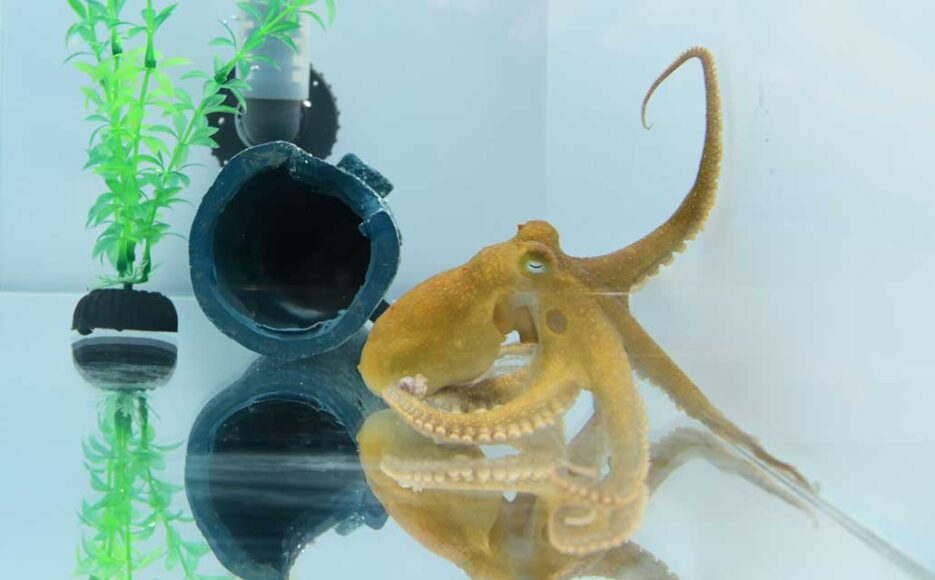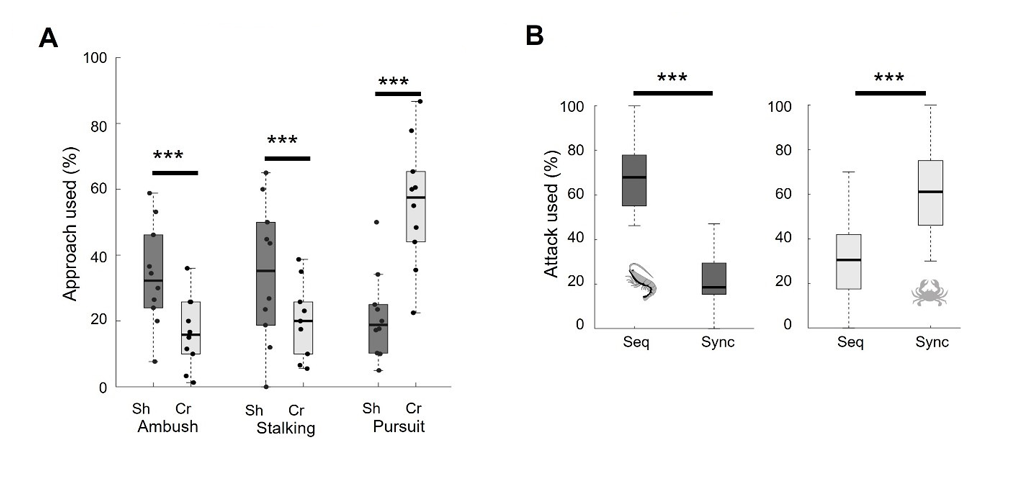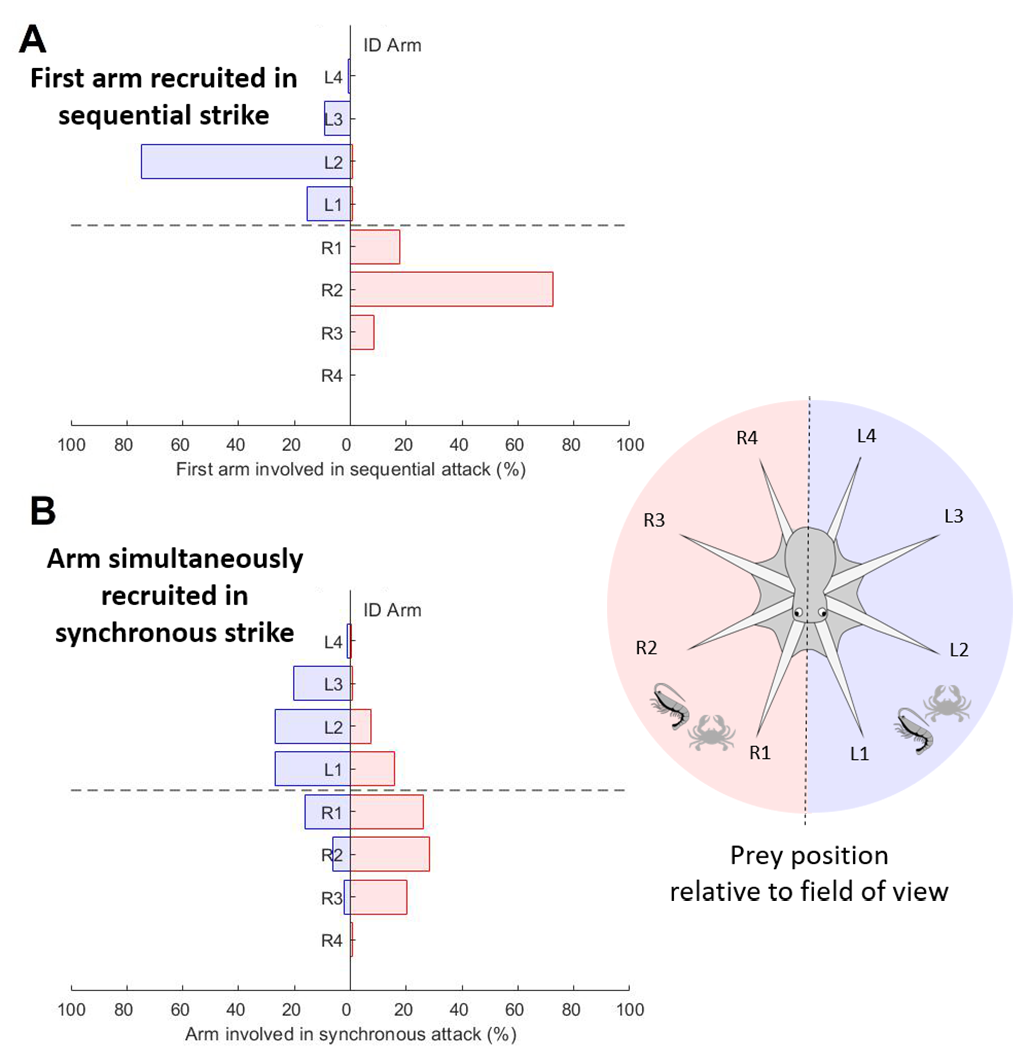Analyze This: Octopuses may use favorite arms for grabbing meals
Researchers tested the tactics these underwater hunters use to catch crabs and shrimp

Researchers dropped crabs and shrimp into an aquarium to watch how California two-spot octopuses hunt and which arms they use. Octopuses used different hunting strategies, from waiting to ambush their prey to chasing them down.
F. Bidel
With eight arms to choose from, octopuses may sometimes play favorites.
Octopuses often hunt by feeling around with their arms, rummaging for prey hiding among rocks. But their hunting can also be guided by what they see. In that case, octopuses have their pick of arms to snag prey. Marine biologist Flavie Bidel and her colleagues were curious how octopuses choose which arms to use. Understanding this could provide clues for engineers designing soft robots, she says.
Bidel’s team watched octopuses hunt to see if they showed any preferences among their arms. She was part of this work while at the University of Minnesota in St. Paul.
The researchers worked with 10 California two-spot octopuses (Octopus bimaculoides). Each tennis ball–sized octopod was given a clay pot den. These cozy spots make good hideouts for octopuses. Before an experiment, the team moved a den with an octopus inside it to a tank where they could film the animal’s behavior.
The scientists then dropped in a prey animal, either a live shrimp or crab. These two critters have different strategies for escaping a predator. A crab immediately skedaddles. “Its reaction is to do a home run — running to its den,” Bidel says. Shrimp move much less. A shrimp may hang out on the tank floor for minutes until a threat becomes imminent. Then, when it’s escape time, the shrimp flings itself away. Shrimp sometimes slip past an octopus’s grasp, but crabs are usually not swift enough to escape, Bidel notes.
Octopus attack strategies

Researchers looked at the different strategies California two-spot octopuses used when hunting crabs (light bars labeled “Cr”) and shrimp (dark bars labeled “Sh”). Figure A shows what percent of the time octopuses used different styles of attack for each type of prey. “Ambush” means the octopus waited in its den so it could surprise prey that moved by. “Stalking” means that the octopus slowly moved its arms to grab the prey. And “pursuit” means the octopus chased the prey. Figure B shows what percent of the time octopuses used different ways of moving their arms for catching shrimp (left) and crabs (right). This can be sequential (one arm at a time, labeled “Seq”) or synchronous (all arms at once, labeled “Sync”).
These “box and whisker plots” show how the data are distributed. Each dot represents the data from an individual octopus. The thick line in the middle of the box is the middle value (called the “median”) if all the observations were lined up smallest to largest. The box includes the half of all data that falls in the middle when the values are lined up. The highest quarter of values and lowest quarter of values fall outside the box. Data points outside of the whiskers are called “outliers.”
Octopuses used a few different hunting strategies, from waiting to ambush their prey to chasing them down. And when the octopuses went to snatch their snacks, the team observed two main ways that the animals used their arms. Octopuses sometimes grabbed with several arms at once. This is called a synchronous (SING-kruh-nuss) attack. Other times, they made a sequential (Sih-KWEN-shul) attack. That means the octopus used its arms one at a time. The octopuses favored different tactics for pursuing shrimp and crabs. And they seemed to have a dominant pair of arms.
Octopuses’ favorite arms
To test which arms octopuses preferred, researchers dropped prey into their tanks. They tried to drop the prey in consistent positions. These spots were either on the right or left of the octopus and nearest the animal’s front two arms. (Data for prey on octopuses’ left sides are shown in blue. Data for prey on the right are shown in red.) Sometimes octopuses used one arm at a time to snatch their prey. Figure A shows how often octopuses used each of their arms first in this type of attack. (Left arms are labeled “L,” right arms are labeled “R.”) Other times, octopuses used several arms at once. Figure B shows how often octopuses used each of their arms in this attack strategy.

The researchers shared their results September 20 in Current Biology.
Now Bidel and her colleagues want to understand the role of octopuses’ brains and nervous systems in choosing which arms to use. Two-thirds of octopuses’ nerve cells, or neurons, are in their arms, Bidel says. The researchers hope to record the electrical signals in the animals’ brains while they hunt. That could help untangle how much an octopus’s brain and its arms are each responsible for these motions.
With their arms galore and complex nervous systems, octopuses may seem like unfamiliar creatures. But Bidel found them similar to the pets that many people love. “They are like cats. They like to play. They like to be social, but not too much,” she says. “They all have different personalities.”
Data Dive:
- Look at Figure A under “Octopus attack strategies.” Which approaches do octopuses tend to use when hunting shrimp? Which approaches do they use more often when hunting crabs?
- Think about the differences between how crabs and shrimp move. Why do you think octopuses prefer different strategies for each?
- Look at Figure B in that same section. How do the values for each type of attack compare for shrimp? How do the values compare for crabs? Which type do octopuses prefer for each prey?
- Look at Figure A under “Octopuses’ favorite arms.” This graph shows which arm the octopus uses first in a sequential attack. When the prey is on the left (blue bars), which arm is usually the first used? What percentage of the time is this the first arm used? When the prey is on the right (red bars), which arm is usually the first used? Compare how often the preferred arms are used first to the other two arms on the same side.
- Look at Figure B in that same section. Which arm is most often part of the attack when prey is on the left (blue bars)? Which arm is most often included when prey is on the right (red bars)?
- Based on your answers, which pair of arms may be octopuses’ favorite?
- The hand that you use most often is your dominant hand. Are you right-handed or left-handed? Write your name with your dominant hand. Now try writing it using your other hand. Which one looks better? What’s the difference in how it feels to write these two different ways?







